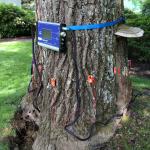Secondary Wood-Rotting Pathogens of Stressed Oaks
New England is home to a variety of oak species that are often some of the largest and most culturally significant trees in both urban and rural settings, providing a variety of services that largely go unobserved. These services may include shade, wind buffering, storm water and pollution capture and increased aesthetics. As trees age, compounding stresses such as insect defoliation and drought can weaken natural defenses, leaving oaks susceptible to infection by root and butt rot fungi. In addition to outright mortality, stem failure as a result of internal decay can result in serious damage to property or people. Root and butt rot of oak can be caused by one of many wood-decaying fungi that are native to our region. The most damaging of these fungal pathogens include: Armillaria spp. (honey mushroom), Ganoderma applanatum (artist’s conk), Inonotus dryadeus (warted oak polypore), Laetiporus sulphureus & L. cincinnatus (chicken of the wood) and Bondarzewia berkeleyi (Berkeley's polypore). Other, less important wood-decaying fungi associated with butt rot of oak trees include Grifola frondosa (hen of the woods) and Ganoderma lucidum (reishi mushroom).
All oak species growing in northeastern North America are susceptible to infection by various wood-decaying fungi. In New England, these oak species include: white oak (Quercus alba), black oak (Q. velutina), red oak (Q. rubra), pin oak (Q. palustris), scarlet oak (Q. coccinea) and chestnut oak (Q. prinus). Damage to trees infected by root and butt rot fungi is often not evident until the tree suffers stem failure during powerful thunderstorms or wind events. In other cases, symptoms of infection are apparent but they cannot be used to definitively conclude the volume of decay in the trunk or roots. Symptoms of root and butt rot can appear as canopy dieback, open cavities at the base of the tree, seams on the trunk with sap flow and extensive tapering (flaring) at the base. Wood-decaying fungi often invade a susceptible host through a wound on the roots or lower trunk, or by directly parasitizing smaller, feeder roots and gradually growing into large, lateral roots and the lower trunk. Once established, many of these fungi decay the heartwood in the center of the root or trunk and do not attack the living sapwood directly. It is hypothesized that these fungi have adapted this strategy to avoid the active defenses of the tree, since the living sapwood and phloem are aggressively defended, whereas the heartwood is non-functional and has only passive chemical defenses.
Management of oaks infected with root and butt rot fungi can be extremely difficult. First, the occurrence of a wood-decaying fungal pathogen must be confirmed. In many cases, the only confirmation is the presence of an annual/perennial fruiting body (mushroom or conk) growing directly from the trunk or from a lateral root close to the base. Regular lawn mowing often destroys fruiting bodies growing from lateral roots before they can mature and be properly identified. In addition, there are numerous mycorrhizal fungi (beneficial fungi that form a mutualistic association with trees) that may produce annual fruiting bodies at the base of oaks. Regular scouting from late July through mid-October is required to find and identify a potential pathogen. Minimizing mechanical wounds that may serve as potential infection points is essential to limit the introduction of these fungi. These wounds may be created by lawnmowers and weed trimmers, nearby landscaping and construction, automobiles, or careless placement of tools and equipment.
An important point to remember is that wood-decaying fungi grow very slowly. It can take these pathogens years to decades to create a volume of decay that is large enough to cause stem failure. The rate of decay varies with tree species, fungal pathogen and location of the pathogen (roots vs. trunk). The presence of some fungal pathogens (e.g. Grifola frondosa) does not always indicate extensive decay is present, whereas others (e.g. Ganoderma applanatum) signify extensive rot has taken place. Accurate identification is critical. Fungicides are of little use against wood-decaying fungi because the pathogen lives within the soil and woody tissue, making it very difficult to contact. Non-destructive detection of internal decay using tomography can be an important tool in determining if a tree is a hazard or remains structurally sound.

